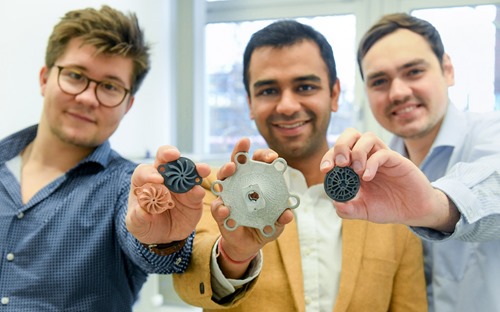3D printing with moon dust for Berlin Adlershof company
/The_Tiwari_team_with_founder_Siddarth_Tiwari.jpg)
A startup based at Science and Technology Park Berlin Adlershof is set to take a giant leap for mankind as it begins 3D printing with synthetic lunar dust.
TIWARI Scientific Instruments (TSI) was founded by Siddharth Tiwari, whom delegates at IASP Virtual 2021 may remember as one of our company speakers. The company already works for many terrestrial customers, including car, plane, and machine builders but now as part of EU project Galactica, they are looking for solutions to print everyday objects and textiles on the moon.
For the startup phase, TIWARI temporarily moved into the Darmstadt-based European Space Agency (ESA) Business Incubator, where in addition to seed money, the company received technology support and simplified access to the elaborate certification required for 3D-printed parts in the aviation and aerospace industry.
For them, TSI takes over 3D printing orders, feasibility studies, and expert support in looking for materials. They consist of metals such as stainless steel, titanium, and copper as well as ceramics, some of which are high-strength, including silicon carbide and nitride, zirconium dioxide or aluminium oxide. TSI mixes plastic filaments with whatever metal or ceramic powder necessary. Extruded through a fine head and deposited layer by layer, they ultimately become a building component. “We achieve accuracy in the 100-micrometre range,” says Tiwari.
While TSI can use off-the-shelf filaments for projects on earth, Galactica involves setting up a novel process chain for future lunar missions, in cooperation with Hochschule Aalen and the company Spartan Space.
This is based on 3D printing using the building material Regolith, otherwise known as man-made lunar dust. It was created by copying material samples collected by the Apollo 11 crew in 1969, and TSI has now printed a collection of samples with varying flexibility which future crews will then use to manufacture everyday objects on the moon. Their goal is to create a cycle with all the ingredients from the onset.
“Because it costs almost a million dollars to transport one kilogram of cargo into space, the aim is to use materials that are available locally,” Tiwari explains. In the distant future, he says, they could be successful in melting down aluminium-rich space debris and bringing it into form using printed regolith molds. For now, however, their mission is to establish a robust process chain for 3D printing with lunar dust.
To find out more about IASP member Science and Technology Park Berlin Adlershof, please visit https://www.adlershof.de/en/
/)


/canvascolor(0xffffffff)/V_1.jpg)
/canvascolor(0xffffffff)/MemberLogo-75401-5958.jpg)
/canvascolor(0xffffffff)/logo_EN_-_Science_Park_UA_1.png)
/canvascolor(0xffffffff)/2017_10_23_Iran_Pardis_Technology_Park.png)
/canvascolor(0xffffffff)/Lion_scienc_park_black_trans_3.png)
/canvascolor(0xffffffff)/2017_08_07_HHTP.png)
/canvascolor(0xffffffff)/Clipboard-2.jpg)
/canvascolor(0xffffffff)/2017_07_25_Germany_Technologiepark_Heidelberg.jpg)
/canvascolor(0xffffffff)/Captura_de_tela_2025-03-06_122825.png)
/canvascolor(0xffffffff)/Technology_Park_Ljubljana.png)
/canvascolor(0xffffffff)/2018_03_30_Canada_Technoparc_Montreal.png)
/canvascolor(0xffffffff)/Logo_biopark_200x200_3.jpg)
/canvascolor(0xffffffff)/2019_11_22_India_IKP.jpg)
/canvascolor(0xffffffff)/2019_08_02_UAE_RTI_Park.png)
/canvascolor(0xffffffff)/New_Logo_sapiens_(1)_page-0001.jpg)
/canvascolor(0xffffffff)/KACSTLogo_1_3.png)
/canvascolor(0xffffffff)/MemberLogo-36401-6008.png)
/canvascolor(0xffffffff)/Jinnovation_Park_logo.png)
/canvascolor(0xffffffff)/sip_zurich_rgb_transparent_1.png)
/canvascolor(0xffffffff)/2024_09_26_Thailand_Northeastern_2.jpg)
/canvascolor(0xffffffff)/logotecnopole_alta_resolucion_1.jpg)
/canvascolor(0xffffffff)/IAA-logo_2048x760-ENG_1.png)
/canvascolor(0xffffffff)/2023_10_09_Brazil_PCT_UNICAMP.jpg)
/canvascolor(0xffffffff)/2017_10_25_Mexico_PIIT_Monterrey.png)
/canvascolor(0xffffffff)/buildings2.png)
